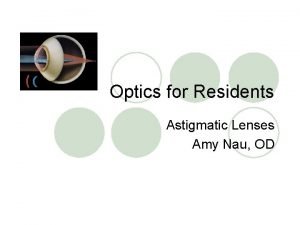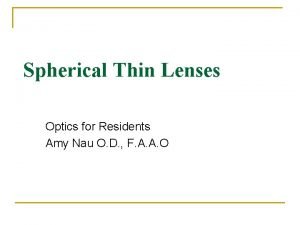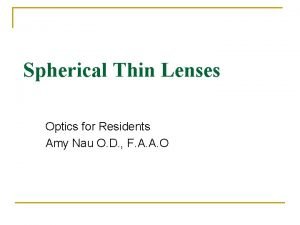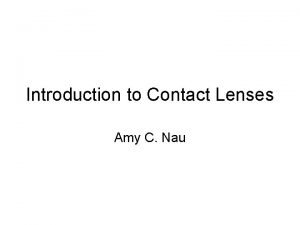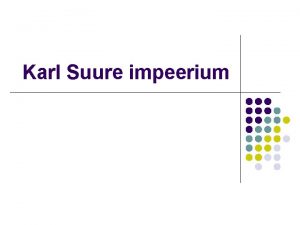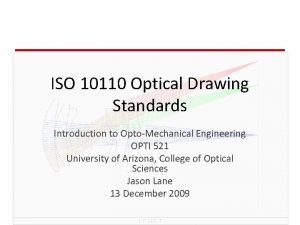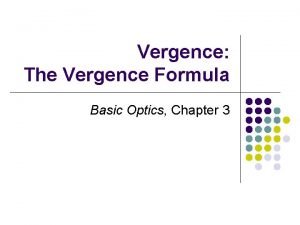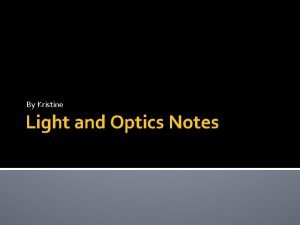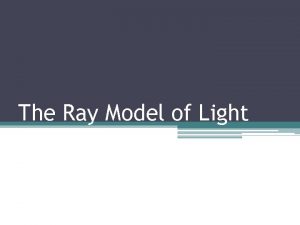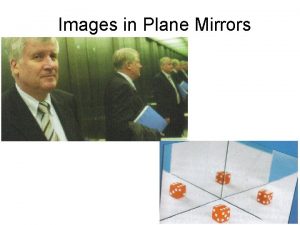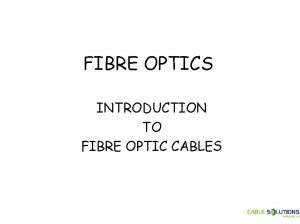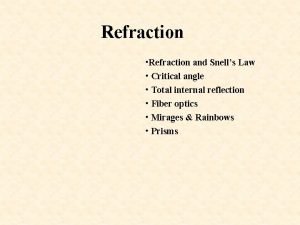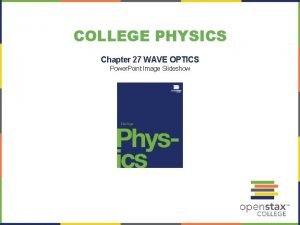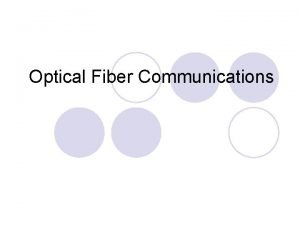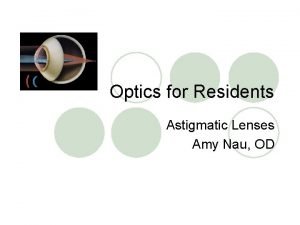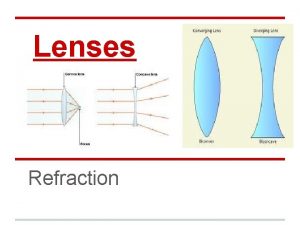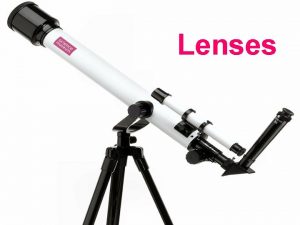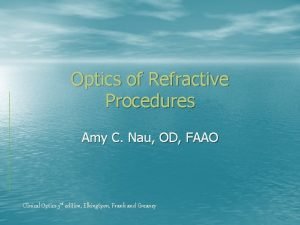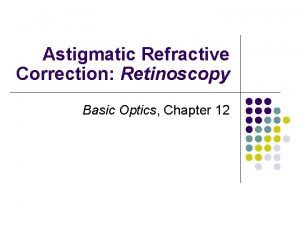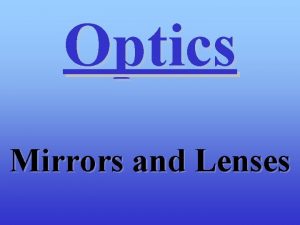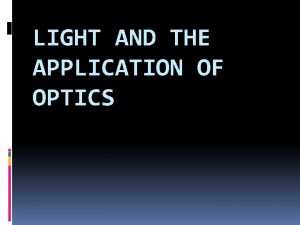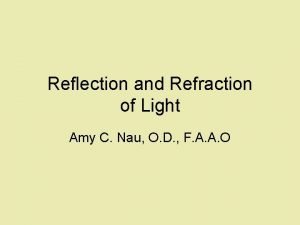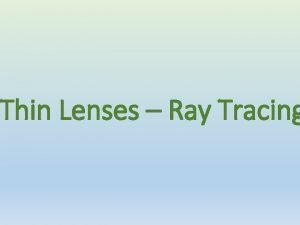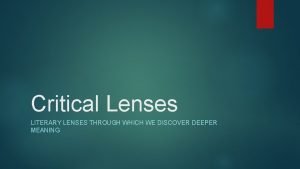Optics for Residents Astigmatic Lenses Amy Nau OD










































- Slides: 42

Optics for Residents Astigmatic Lenses Amy Nau, OD

Astigmatic Lenses l Spherical lenses form a point image for each object point ¡Stigmatic = point-like l Toroidal are not-point-like ¡Astigmatic! ¡This is a second order aberration

Toroidal Surfaces l Have two radii of curvature r 1 r 3 r 2

Toroidal Surfaces The surface is created by two radii of unequal length, Each in a plane at right angle to the other Vertical plane 1 r 1=r 2 P=n 1 -n 2/r For any object vergence, a toric Surface creates two separate images. 2 H pl ori an zo e nt al

The astigmatic image- plano cyl r 1 r 1 r 2 Looks like a stack of thin plus lenses, each Of the same refracting power

The astigmatic lens- plano cyl Cylinder axis Say each lens has P=5 D. Then if we put an Object 50 cm in front of them, EACH lens forms A point image 33 cm away. The final composite image will be a series of Points oriented in a straight vertical line r 1 x HORIZONTAL LENS FORMS VERTICAL LINE IMAGE X’ X’ X’

Astigmatic Lenses-plano cyl Ho X’ riz on ta X’ ll in e im X’ ag e X’ x VERTICAL LENS FORMS HORIZONTAL LINE IMAGE

Astigmatic Lens- plano cyl r 1 is shorter than r 2, so the power of r 1 will be greater than r 2. Vertical plane F=n 1 -n 2/r 1 Therefore, the VERGENCE of the two Powers will be different 2 H pl ori an zo e nt Recall do+di=1/f al and F=1/f So, if F 1>F 2, then di 2 is farther from The lens than di 1

Astigmatic Lens- plano cyl All toroidal surfaces have two major meridians- the one with the max power and the one with minimal power 90 degrees away. Each will form a line image, so what happens in the plano (no power) meridian? Vertical lens Each horizontal slice Has parallel faces w/o Curvature and thus no Refractive power. Same Alignment as axis.

Problem type Find the powers of a plano cyl lens using radius information. Determine image position using radius information.

Maddox Rod This is used to test EOM imbalances. Re a X lh ori zo nta l li ne im ag point source THE MADDOX ROD IS A STACK OF THESE LENSES ALL TOGETHER. Position of virtual, vertical line image, same position as X e

Maddox Rod l This vertical line image is virtual l Cannot be focused on a screen l CAN be seen when looked at through the lens towards X. X Since the eye is very close to the lens, the horizontal line is not seen. The eye then sees the virtual, VERTICAL image line that appears to be Located at the object point (where the light is).

Maddox Rod Eye sees VIRTUAL horizontal image Eye sees VIRTUAL vertical image Remember the eye behind the red lens (OD) deviates in the direction OPPOSITE to that of the virtual red line.

Problem Type l Know generally how Maddox rod works. l Know what occurs clinically!

The Cross Diagram Take the example some power, P x 180 This has a maximum power is located in the vertical meridian. {An equivalent expression would be P@90 - this is how K’s are expressed. } +1. 00 = +2. 00 x 180 +1. 00 +2. 00 +3. 00 = +1. 00 pl +1. 00

Transpositon +3. 00 = -2. 00 x 090 +3. 00 pl +3. 00 = +1. 00 Combined cyl +3. 00 -2. 00

Transposition +3. 00 = -2. 00 x 090 is same as +1. 00= +2. 00 X 180 +2. 00 +1. 00 +3. 00 = +1. 00 pl

Problem Types Be able to convert an Rx into a cross diagram Be able to convert a cross diagram into an Rx Know how to transform between plus and minus cyl Draw cross diagrams in plus and minus form

The Circle of Least Confusion +3. 00 x 180 X’v X’h +5. 00 x 090 x 20 cm 33 cm

The Circle of Least Confusion Interval of Sturm - distance between the two line images X’v X’h x CLC

CLC l Vergence at the clc is the average emergent vergence leaving the lens. l Lc=L 1+L 2/2 l The location of the clc is the reciprocal of Lc

The Circle of Least Confusion +8. 00+2. 00 x 180 2 8 8 Object is placed 1 m in front of this lens. L’=F+L L’=10 -1=9 D and l’=11. 11 cm L’’=F+L L’’=8 -1=7 D and l’’=14. 28 cm Location of clc = reciprocal of average verg. L’c=L’+L’’/2 = (9+7)/2 = 8 D; and l’c=1/L’c so, l’c=1/8 =12. 5 cm 10 pl 8

Spherical equivalent l Take ½ the cyl and add to sphere l -4. 00+1. 00 x 180 becomes l -3. 50 D l Good for patients who can’t tolerate cyl in spectacles l Good for contact lenses

Problem types Understand the terminology Know how to calculate the length of the conoid of Sturm Know how to find the spherical equivalent in an Rx Know how to locate the CLC

Images of Extended Objects Horiz meridian focus Vertical meridian focus E Circle focus

Images of Extended Objects If the astigmatism is such that the two cyl axes are not Oriented vertically and horizontally but at some other position, Each image line is still parallel to the corresponding axis Axis 45 Axis 135

Differential Motion of Image Lines It is possible to move only ONE part of a toric image P 1 X 090 combined with P 2 X 180 You can place a new cyl lens in front of the above, P 3 x 180 PL p 2 p 1 p 3 PL + PL The result is (p 2 + p 3) x 180. P 1 is unaffected! If p 3 is +, pulls the horizontal line image closer to the lens itself If p 3 is - , the vergence is decreased and the image is pushed away THIS IS HOW THE JCC LENS WORKS…………………

Differential Motion of Line Images l You can move both the horizontal and vertical images simultaneously pl p 3 p 2 p 1 pl + p 3 (p 1+p 3)x 180 combined with (p 2+p 3) x 090 Changes the vergence in both meridians equally If it is of the proper strength, the concoid of Sturm Can be collapsed, thus eliminating the astigmatism

Differential Motion of Line Images P 1 @ 090 P 2 @ 180 -p 3 @ 180 +3 D sph P 1 P 2

Differential Motion of Line Images Note that the image moves equally, but only in the dioptric sense—the linear distance moved by the more distant line must be greater that moved by the closer line. This is due to proximity to the lens (vertex) A 1 cm linear distance between 10 and 11 cm corresponds To a dioptric change of 0. 9 D A 1 cm linear distance between 25 and 26 cm corresponds To a dioptric change of. 15 D =. 9 D 10 11 =. 15 D 25 26

Cyl orientation (convention) The 0 -180 axis (horizontal) 0 begins at the patients LEFT ear and rotates counterclockwise when you are facing the patient. This is true for both eyes. 120 deg 180 30 deg 0 Left reference ear

Meridional Powers of Cyl Lenses What about the powers between the major meridians? ? ? The power gradation from max to min is NOT a straight line change; the power gain moving from the axis meridian (min) to the maximum increases by the sin 2 of the angle away from the axis. 60 F(sin 2 f) In this 3 D cyl, the power in the meridian 60 to the axis is 3(sin 260) = 3(. 866)2 = 3(. 75) = +2. 25 D

Meridional power of cyl lenses l Factoid l For any spherocylinder lens, the power in the meridian 45 degrees to the axis (that is, halfway between the max and min meridional powers) is always the spherical equivalent of that lens.

Problem type l Be able to calculate an off axis power l What is the power at 45 degrees? l -1. 00 -2. 00 x 180? A. -2. 00 D

Jackson Cross Cylinder A toric lens that is composed of a + cyl and – cyl of equal powers ground on to one lens, with their axes at right angles To each other. The strength of the cyl is always two times, and of opposite sign to the power of the sphere +1. 00 = -2. 00 x 180 or -0. 25 + 0. 50 x 090 ALL CROSS CYL LENSES HAVE AN EQUIVALENT POWER OF ZERO THUS, THE CLC WILL NOT BE MOVED! - + Plus axis at 90 - + + + - The meridians marked are the axes! Plus axis at 180

JCC for power refinement + axis at 180 - Axis at 090 Both focal lines will move away from each other And the astigmatism will increase (CLC increases in size) + axis at 090 - Axis at 180 Both focal lines will move towards each other And the astigmatism will decrease (CLC decreases In size) Note the position of the clc is stationary

JCC for power refinement Clinically, the CLC is placed as Close to the retina as possible Using the sphere powers (usually the spherical equivalent). Then The patient can determine if the size of the blur circle increases or decreases As soon as the patient can no longer tell the difference, then the Interval of sturm is collapsed, and there is “no more” astigmatism.

Problem type l Be able to recognize a JCC in Rx form l Be able to write JCC in Rx format l Understand how it works in general terms.

Learning Goals l Nature of torics l Maddox rod optics l Cross diagrams l Transposition l CLC l Images formed by torics l Manipulation of image position l Meridional (off axis) powers l Optics of the JCC

Free Optics Textbook online l http: //www. lightandmatter. com/bk 5 a. pdf


Is it moving and shimmering? Buy a poster! Look at this illusion for a while and it will appear to be shimmering and moving. Also: Follow the outermost groove and watch it change from a groove to a hump as you go around the wheel.
 Psfm ne demek
Psfm ne demek Difference between ray optics and wave optics
Difference between ray optics and wave optics Reflection and refraction venn diagram
Reflection and refraction venn diagram Nau optics
Nau optics Power of lens
Power of lens Amy nau
Amy nau Thin lens vergence equation
Thin lens vergence equation Amy nau
Amy nau Uf neurology residency
Uf neurology residency Uthscsa internal medicine residents
Uthscsa internal medicine residents Amy lee plastic surgery
Amy lee plastic surgery 13 personal care skills
13 personal care skills Uihc internal medicine residency
Uihc internal medicine residency Paro contract
Paro contract Karl suure pealinn
Karl suure pealinn Umass neurology residency
Umass neurology residency Famous yonkers residents
Famous yonkers residents Informed delivery for business mailers
Informed delivery for business mailers Tufts anesthesiology residency
Tufts anesthesiology residency Tourism involving non-residents of the given area.
Tourism involving non-residents of the given area. Williamson medical center pharmacy residency
Williamson medical center pharmacy residency Slu ent residents
Slu ent residents University of new mexico internal medicine residency
University of new mexico internal medicine residency Unmc obgyn
Unmc obgyn Nutrition and hydration chapter 15
Nutrition and hydration chapter 15 Dr sarah gernhart
Dr sarah gernhart Bill nye light optics
Bill nye light optics Iso 10110-7
Iso 10110-7 Vergence formula optics
Vergence formula optics Light and optics notes
Light and optics notes Name the two parts that make up most mirrors
Name the two parts that make up most mirrors How does salt help you describe the properties of an image
How does salt help you describe the properties of an image Optical fibre cable
Optical fibre cable Optics
Optics Fiber optics richard sanders
Fiber optics richard sanders What is optics
What is optics Free space optics
Free space optics Critical angle of light
Critical angle of light Astigmatisml
Astigmatisml Grade 10 optics review
Grade 10 optics review Optics
Optics Types of optics
Types of optics Fiber optic disadvantages
Fiber optic disadvantages



